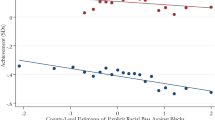Abstract
The rigorous economic analysis of peer group formation is a burgeoning subject. Much has been written about how peers influence an individual’s behavior, and these effects are quite prevalent. However, less has been written on how exactly these peer groups begin and the resulting consequences of their formation. A reason for the dearth of knowledge on peer group formation is the lack of quality data sets that clearly define one’s peers. To resolve this issue, this paper explores data which allows a peer group to be defined openly through self nominations. Using these nominations as well as characteristics of the students and their friends, it is possible to see on what dimensions these individuals are sorting into friendships. The data suggests that there is heavy sorting within race and academic ability. Additionally, tests for statistical discrimination on race and academics show that it is exhibited towards blacks and Hispanics. There is also weak evidence of statistical discrimination against whites. Empirical analysis also shows that the degree of statistical discrimination decreases for blacks and Hispanics over a year. however, there is little change for whites over the same period.
Similar content being viewed by others
Notes
A good example is Boston’s Metropolitan Council for Educational Opportunity (Metco) Program, which redistributes minorities that must meet a certain academic standard across schools in the Greater Boston area. The main aims of the program are to help desegregate Boston area schools as well as provide opportunities to certain minorities by transferring them to advantageous school districts.
Manski (1993) defines the reflection problem.
If romantic and platonic relationships across races and achievement do not follow the same patterns, then platonic friendship results can be biased by including romantic partners among friends. There are patterns in interracial romances that belie the general population (Foeman and Nance 1999). Concentrating on same-gender friendships eliminates most romantic relationship possibilities. Another assumption is that male-female platonic friendships follow similar patterns to same-gender platonic friendships.
A check was instituted using the In-School survey, where there are no sample size problems. The degree of self-segregation among high-achieving blacks was confirmed to be higher than the degree of self-segregation among low-achieving blacks in that sample as well.
In this particular context, an individual with a GPA of 3.3 (B+) or above is considered a “high” achiever, while an individual with GPA below 3.3 is considered a “low” achiever. While seemingly arbitrary, changes are negligible with alternate definitions of achievement.
A check was instituted using the In-School survey, where there are no sample size problems. The degree of self-segregation among high-achieving blacks was confirmed to be higher than the degree of self-segregation among low-achieving blacks in that sample as well.
Individuals may nominate friends from multiple racial groups, and these individuals are counted accordingly in the appropriate regression.
One way to correct for the inflation is to change the boundaries of better, similar, or worse to a non-fixed number, such as deciles, instead.
A model similar to Eq. 4 was estimated, except without the embedded coefficients in the squared term.
See footnote 1 regarding the Metco program.
References
Akerlof, G., & Kranton, R. (2002). Identity and schooling: some lessons learned for the economics of education. Journal of Economic Literature, 40, 1167–1201.
Arcidiacono, P., & Vigdor, J. (2009). Does the river spill over? Estimating the economic returns to attending a racially diverse college. Economic Inquiry, 48(3), 537–557.
Arcidiacono, P., Khan, S., & Vigdor, J. (2011). Representation versus assimilation: how do preferences in college admissions affect social interactions? Journal of Public Economics, 95(1–2), 1–15.
Bifulco, R., & Ladd, H. (2007). School choice, racial segregation, and test score gaps: evidence from North Carolina’s charter school program. Journal of Policy Analysis and Management, 26(1), 31–56.
Blau, P. M. (1964). Exchange and power in social life. Transaction Publishers. New York: Wiley.
Bowen, W., & Bok, D. (2000). The shape of the river: Long term consequences of considering race in college and university admissions. Princeton: Princeton University Press.
Clotfelter, C. (2004). After brown: The rise and retreat of school desegregation. Princeton: Princeton University Press.
Foeman, A., & Nance, T. (1999). From miscegenation to multiculturalism: perceptions and stages of interracial relationship development. Journal of Black Studies, 29, 540–557.
Foster, J. R. (2005). Making friends: a non-experimental analysis of social group formation. Human Relations, 58, 1443–1465.
Manski, C. (1993). Identification of endogenous social effects: the reflection problem. Review of Economic Studies, 40, 531–542.
Marmaros, D., & Sacerdote, B. (2006). How do friendships form? Quarterly Journal of Economics, 121(1), 79–119.
Moody, J. (2001). Race, school integration, and friendship segregation in America. American Journal of Sociology, 107, 679–716.
Raino, K. (1966). “A Study of Sociometric Group Structure: An Application of a Stochastic Theory of Social Interaction”. In J. Berger, M. Zelditch, and B. Anderson, Sociological Theories in Progress, Vol.1, Houghton Mifflin.
Rumberger, R., & Palardy, G. (2001). Does segregation still matter? The impact of student composition on academic achievement in high school. Teachers College Record, 107, 1999–2045.
Tuma, N. B., & Hallinan, M. (1979). The effects of sex, race and achievement on schoolchildren’s friendships. Social Forces, 57, 1265–1285.
Udry, J. R. (2003). The National Longitudinal Study of Adolescent Health (Add Health), Waves I and II, 1994–1996; Wave III, 2001–2002 [machine-readable data file and documentation]. Chapel Hill: Carolina Population Center, University of North Carolina at Chapel Hill.
Zeng, Z., & Xie, Y. (2008). A preference-opportunity-choice framework with applications to intergroup friendship. American Journal of Sociology, 114(3), 615–648.
Acknowledgments
This research uses data from Add Health, a program project designed by J. Richard Udry, Peter S. Bearman, and Kathleen Mullan Harris, and funded by a grant P01-HD31921 from the Eunice Kennedy Shriver National Institute of Child Health and Human Development, with cooperative funding from 17 other agencies. Special acknowledgment is due Ronald R. Rindfuss and Barbara Entwisle for assistance in the original design. Persons interested in obtaining data files from Add Health should contact Add Health, Carolina Population Center, 123 W. Franklin Street, Chapel Hill, NC 27516–2524 (addhealth@unc.edu). No direct support was received from grant P01-HD31921 for this analysis.
Author information
Authors and Affiliations
Corresponding author
Rights and permissions
About this article
Cite this article
Nathan, A. Sorting and Statistical Discrimination in Schools. Atl Econ J 43, 271–287 (2015). https://doi.org/10.1007/s11293-015-9457-3
Published:
Issue Date:
DOI: https://doi.org/10.1007/s11293-015-9457-3
Keywords
- National Longitudinal Study of Adolescent Health
- Add Health
- Friendship formation
- Statistical discrimination
- School redistribution




